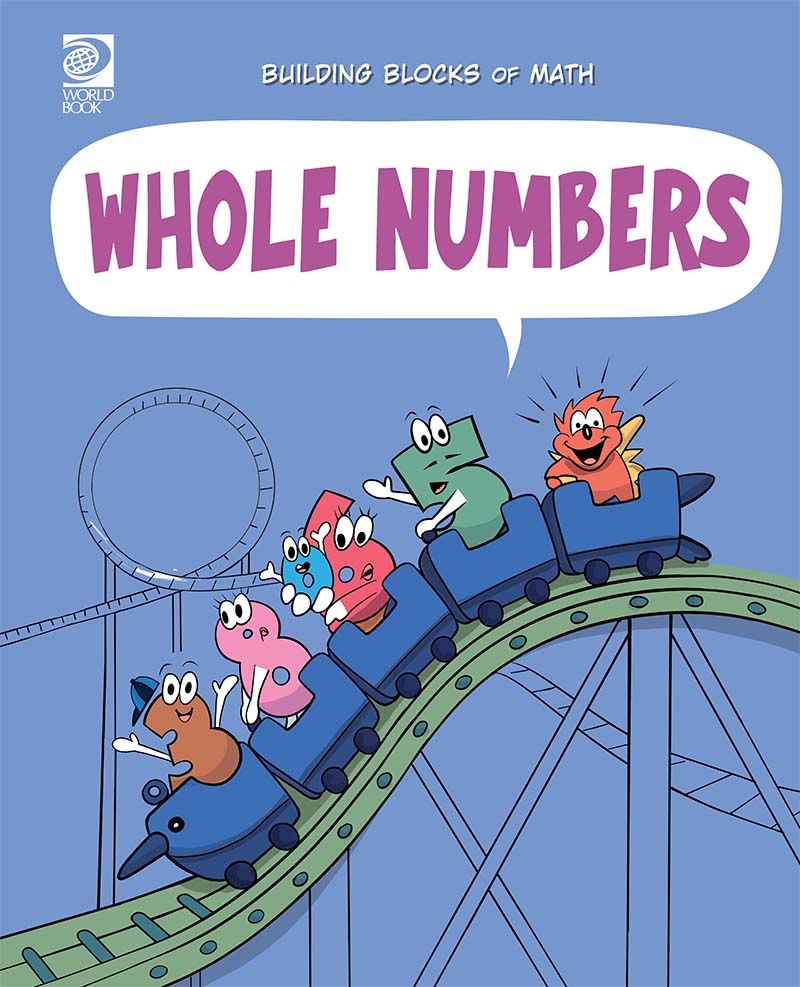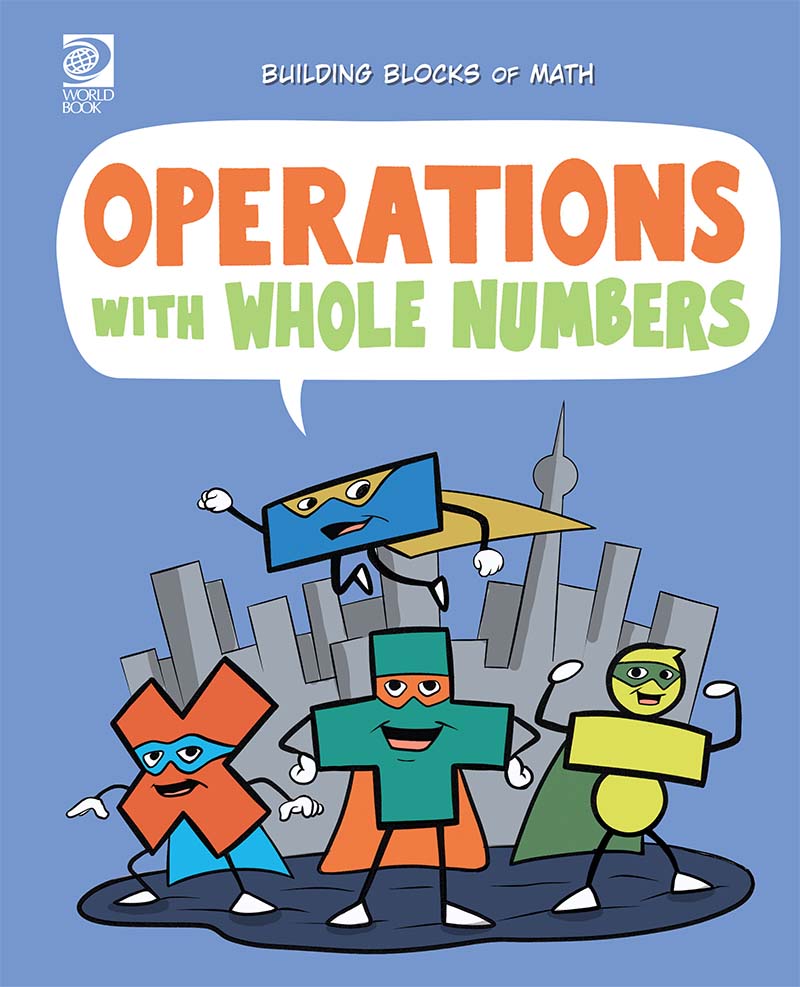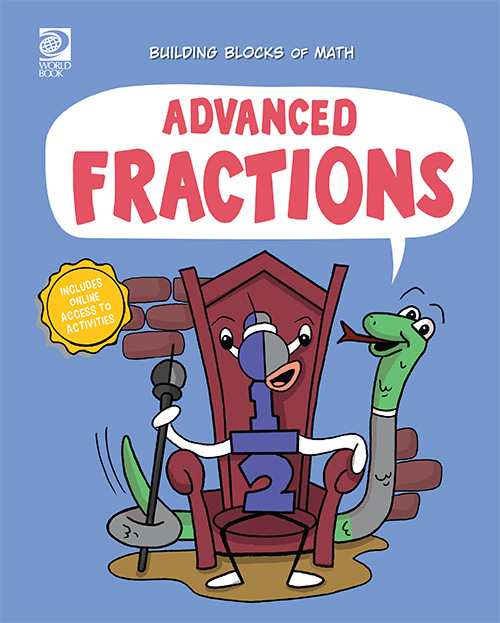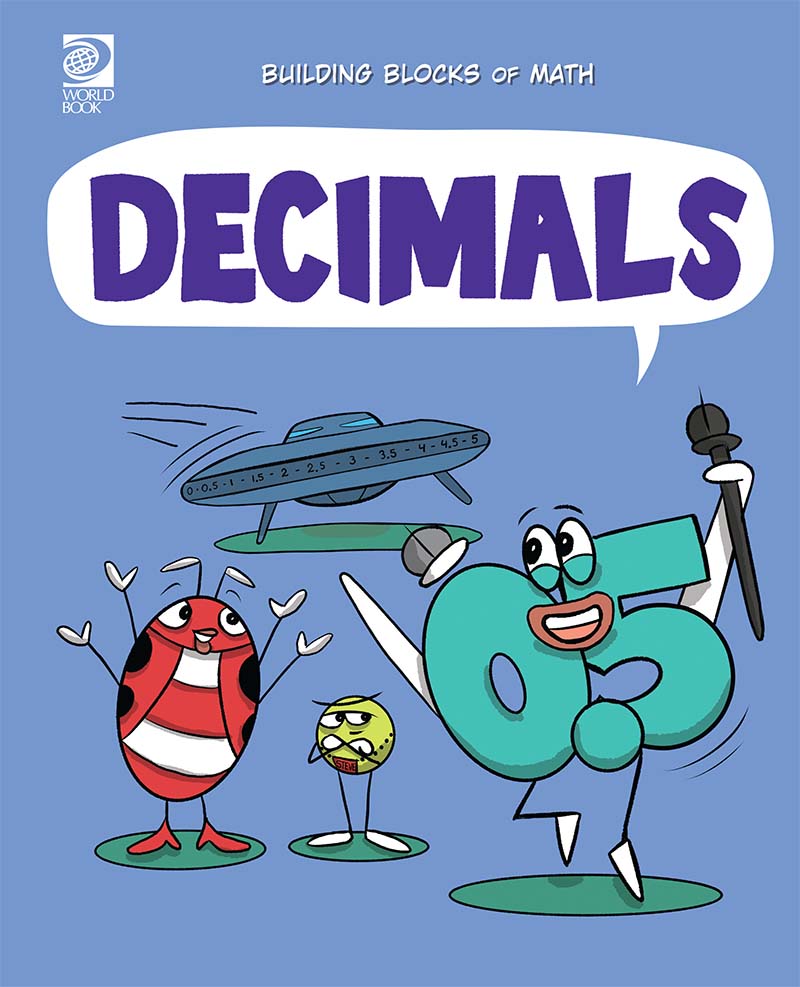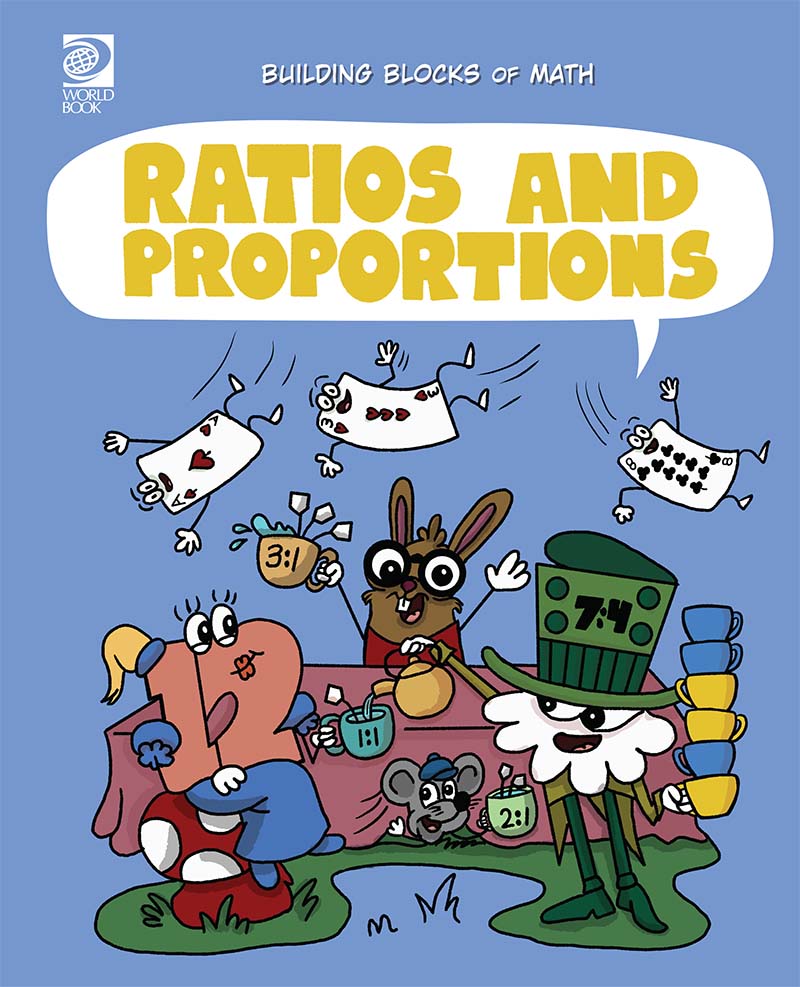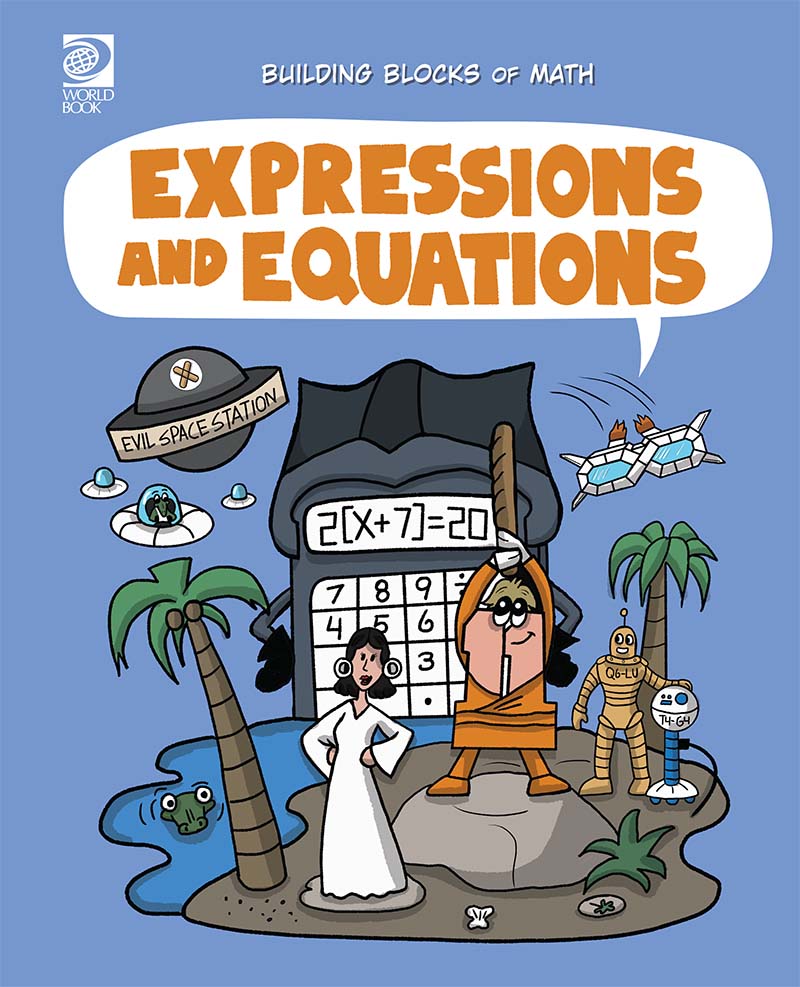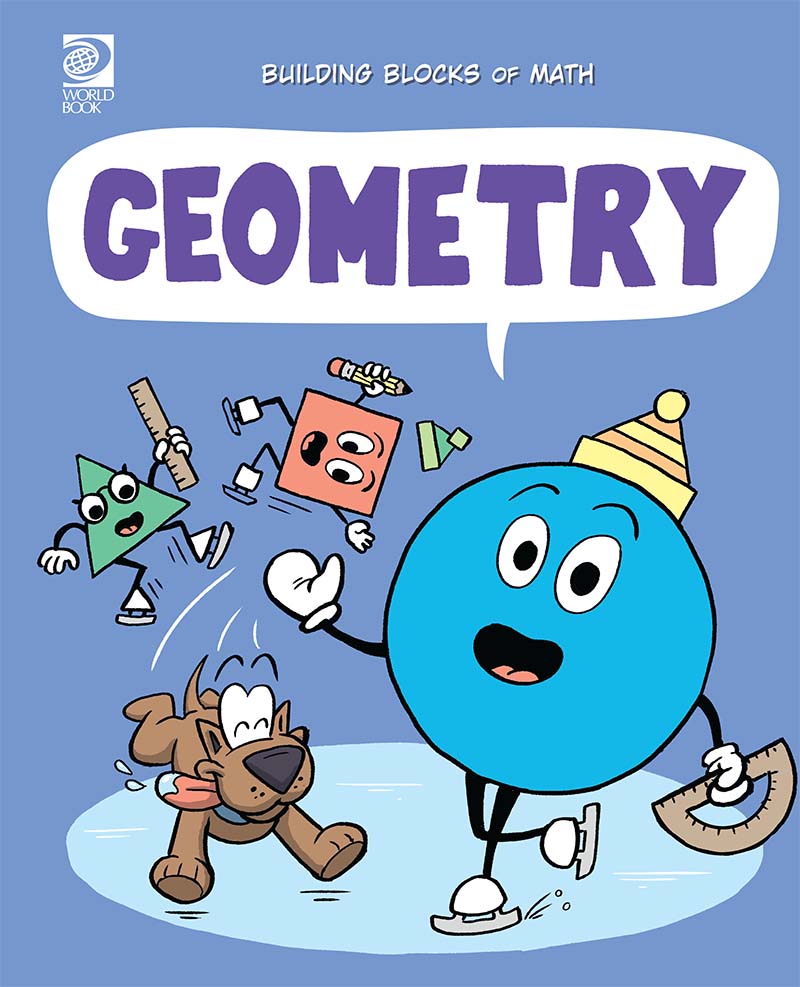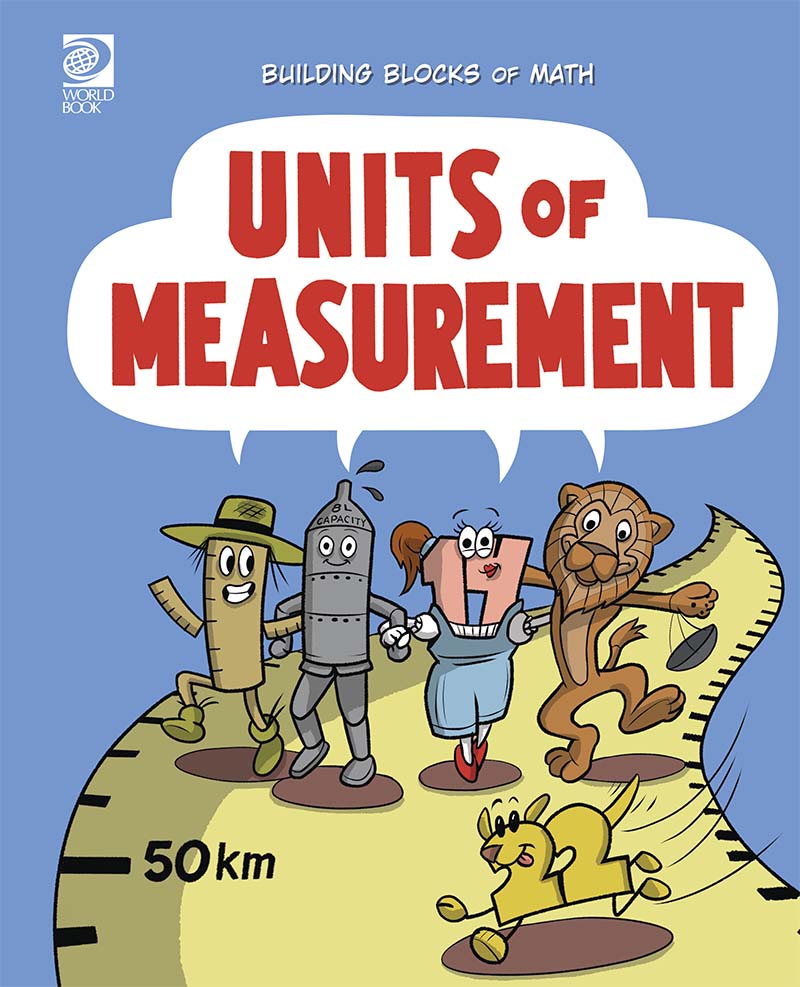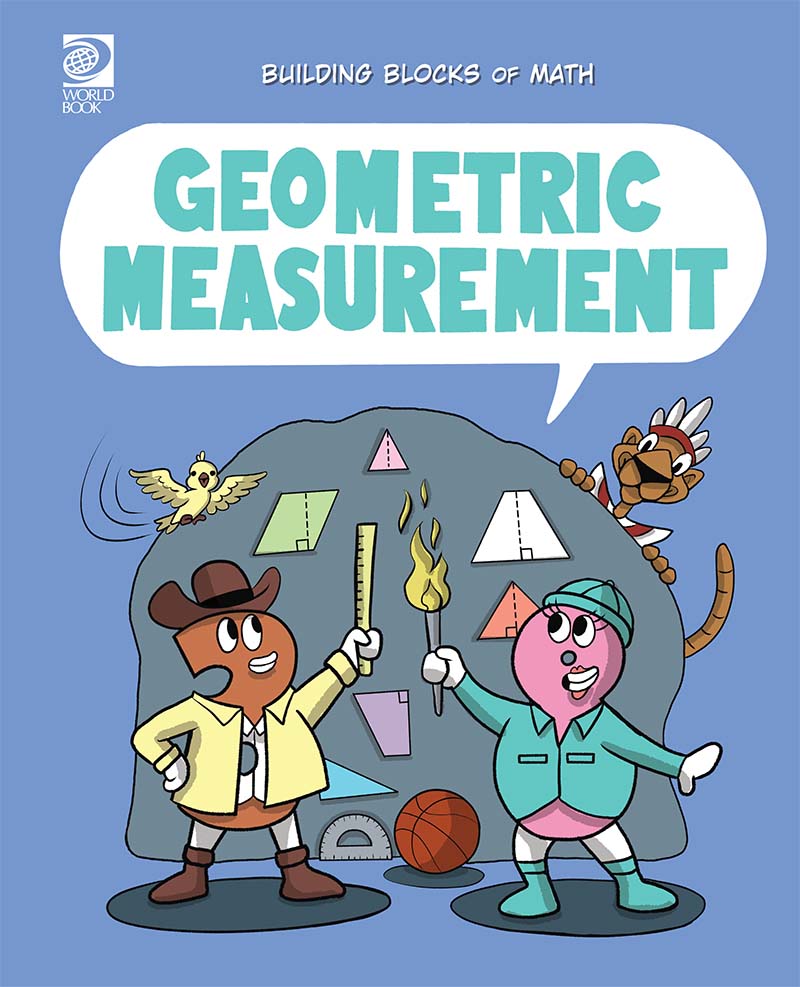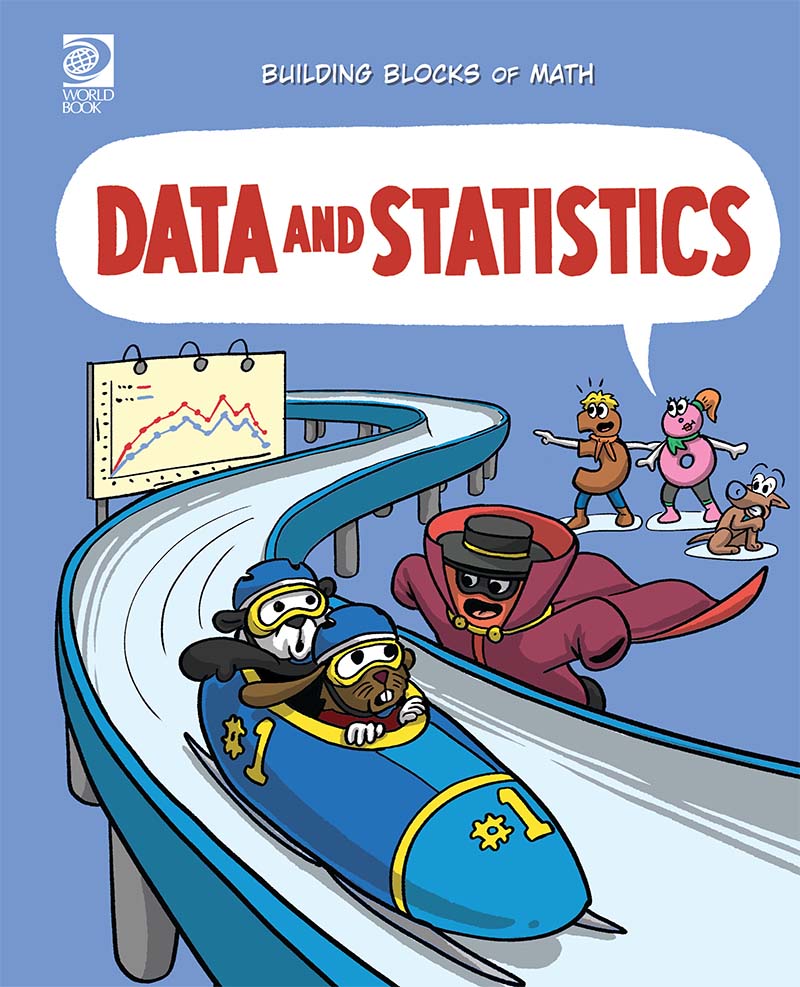Building Blocks of Math: Moving Beyond Foundations
The Building Blocks of Math: Moving Beyond Foundations Educator Section includes tools as well as ready-to-use classroom materials. Educators can see how the Common Core State Mathematics Standards and the Common Core State Standards for Mathematical Practice align with the Building Blocks of Math: Moving Beyond Foundations books, organized by the grade level(s) they teach. In addition, educators will have access to reading resources such as discussion guides and comprehension checks. Provided classroom activities can be used to support students’ number sense understanding, flexibility with numbers, and overall confidence with math. Finally, the Educators Section also includes engaging lessons, centered around standards, with built-in differentiation options to support all learners as they continue to explore this content.
Building Blocks of Math Standards Alignment:
Use this section to view how the Common Core State Mathematics Standards and the Common Core State Standards for Mathematical Practice align to the Building Blocks of Math: Moving Beyond Foundations series.
-
Common Core State Standards for Mathematical Practice Students who demonstrate understanding can:
Mathematical Practice Standard Mathematical Practice Details Building Blocks Book(s) MP1 Make sense of problems and persevere in solving them. Mathematically proficient students start by explaining to themselves the meaning of a problem and looking for entry points to its solution. They analyze givens, constraints, relationships, and goals. They make conjectures about the form and meaning of the solution and plan a solution pathway rather than simply jumping into a solution attempt. They consider analogous problems, and try special cases and simpler forms of the original problem in order to gain insight into its solution. They monitor and evaluate their progress and change course if necessary. Older students might, depending on the context of the problem, transform algebraic expressions or change the viewing window on their graphing calculator to get the information they need. Mathematically proficient students can explain correspondences between equations, verbal descriptions, tables, and graphs or draw diagrams of important features and relationships, graph data, and search for regularity or trends. Younger students might rely on using concrete objects or pictures to help conceptualize and solve a problem. Mathematically proficient students check their answers to problems using a different method, and they continually ask themselves, "Does this make sense?" They can understand the approaches of others to solving complex problems and identify correspondences between different approaches. Operations with Whole Numbers, Fractions, Decimals, Ratios and Proportions, Expressions and Equations, Geometric Measurement, Data and Statistics MP2 Reason abstractly and quantitatively. Mathematically proficient students make sense of quantities and their relationships in problem situations. They bring two complementary abilities to bear on problems involving quantitative relationships: the ability to decontextualize—to abstract a given situation and represent it symbolically and manipulate the representing symbols as if they have a life of their own, without necessarily attending to their referents—and the ability to contextualize, to pause as needed during the manipulation process in order to probe into the referents for the symbols involved. Quantitative reasoning entails habits of creating a coherent representation of the problem at hand; considering the units involved; attending to the meaning of quantities, not just how to compute them; and knowing and flexibly using different properties of operations and objects. Operations with Whole Numbers, Fractions, Decimals, Ratios and Proportions, Expressions and Equations, Data and Statistics MP3 Construct viable arguments and critique the reasoning of others. Mathematically proficient students understand and use stated assumptions, definitions, and previously established results in constructing arguments. They make conjectures and build a logical progression of statements to explore the truth of their conjectures. They are able to analyze situations by breaking them into cases, and can recognize and use counterexamples. They justify their conclusions, communicate them to others, and respond to the arguments of others. They reason inductively about data, making plausible arguments that take into account the context from which the data arose. Mathematically proficient students are also able to compare the effectiveness of two plausible arguments, distinguish correct logic or reasoning from that which is flawed, and—if there is a flaw in an argument—explain what it is. Elementary students can construct arguments using concrete referents such as objects, drawings, diagrams, and actions. Such arguments can make sense and be correct, even though they are not generalized or made formal until later grades. Later, students learn to determine domains to which an argument applies. Students at all grades can listen or read the arguments of others, decide whether they make sense, and ask useful questions to clarify or improve the arguments. Ratios and Proportions, Geometry, Geometric Measurement, Data and Statistics MP4 Model with mathematics. Mathematically proficient students can apply the mathematics they know to solve problems arising in everyday life, society, and the workplace. In early grades, this might be as simple as writing an addition equation to describe a situation. In middle grades, a student might apply proportional reasoning to plan a school event or analyze a problem in the community. By high school, a student might use geometry to solve a design problem or use a function to describe how one quantity of interest depends on another. Mathematically proficient students who can apply what they know are comfortable making assumptions and approximations to simplify a complicated situation, realizing that these may need revision later. They are able to identify important quantities in a practical situation and map their relationships using such tools as diagrams, two-way tables, graphs, flowcharts and formulas. They can analyze those relationships mathematically to draw conclusions. They routinely interpret their mathematical results in the context of the situation and reflect on whether the results make sense, possibly improving the model if it has not served its purpose. Operations with Whole Numbers, Fractions, Decimals, Ratios and Proportions, Expressions and Equations, Geometry, Units of Measurement, Geometric Measurement, Data and Statistics MP5 Use appropriate tools strategically. Mathematically proficient students consider the available tools when solving a mathematical problem. These tools might include pencil and paper, concrete models, a ruler, a protractor, a calculator, a spreadsheet, a computer algebra system, a statistical package, or dynamic geometry software. Proficient students are sufficiently familiar with tools appropriate for their grade or course to make sound decisions about when each of these tools might be helpful, recognizing both the insight to be gained and their limitations. For example, mathematically proficient high school students analyze graphs of functions and solutions generated using a graphing calculator. They detect possible errors by strategically using estimation and other mathematical knowledge. When making mathematical models, they know that technology can enable them to visualize the results of varying assumptions, explore consequences, and compare predictions with data. Mathematically proficient students at various grade levels are able to identify relevant external mathematical resources, such as digital content located on a website, and use them to pose or solve problems. They are able to use technological tools to explore and deepen their understanding of concepts. Fractions, Ratios and Proportions, Expressions and Equations, Geometry, Units of Measurement, Geometric Measurement, Data and Statistics MP6 Attend to precision. Mathematically proficient students try to communicate precisely to others. They try to use clear definitions in discussion with others and in their own reasoning. They state the meaning of the symbols they choose, including using the equal sign consistently and appropriately. They are careful about specifying units of measure, and labeling axes to clarify the correspondence with quantities in a problem. They calculate accurately and efficiently, express numerical answers with a degree of precision appropriate for the problem context. In the elementary grades, students give carefully formulated explanations to each other. By the time they reach high school they have learned to examine claims and make explicit use of definitions. Whole Numbers, Operations with Whole Numbers, Decimals, Ratios and Proportions, Expressions and Equations, Geometry, Units of Measurement, Geometric Measurement, Data and Statistics MP7 Look for and make use of structure. Mathematically proficient students look closely to discern a pattern or structure. Young students, for example, might notice that three and seven more is the same amount as seven and three more, or they may sort a collection of shapes according to how many sides the shapes have. Later, students will see 7 × 8 equals the well remembered 7 × 5 + 7 × 3, in preparation for learning about the distributive property. In the expression x2 + 9x + 14, older students can see the 14 as 2 × 7 and the 9 as 2 + 7. They recognize the significance of an existing line in a geometric figure and can use the strategy of drawing an auxiliary line for solving problems. They also can step back for an overview and shift perspective. They can see complicated things, such as some algebraic expressions, as single objects or as being composed of several objects. For example, they can see 5 - 3(x - y)2 as 5 minus a positive number times a square and use that to realize that its value cannot be more than 5 for any real numbers x and y. Whole Numbers, Operations with Whole Numbers, Fractions, Decimals, Ratios and Proportions, Expressions and Equations, Geometry, Units of Measurement, Geometric Measurement, Data and Statistics MP8 Look for and express regularity in repeated reasoning. Mathematically proficient students notice if calculations are repeated, and look both for general methods and for shortcuts. Upper elementary students might notice when dividing 25 by 11 that they are repeating the same calculations over and over again, and conclude they have a repeating decimal. By paying attention to the calculation of slope as they repeatedly check whether points are on the line through (1, 2) with slope 3, middle school students might abstract the equation (y - 2)/(x - 1) = 3. Noticing the regularity in the way terms cancel when expanding (x - 1)(x + 1), (x - 1)(x2 + x + 1), and (x - 1)(x3 + x2 + x + 1) might lead them to the general formula for the sum of a geometric series. As they work to solve a problem, mathematically proficient students maintain oversight of the process, while attending to the details. They continually evaluate the reasonableness of their intermediate results. Fractions, Decimals, Ratios and Proportions, Expressions and Equations, Geometry, Units of Measurement, Data and Statistics -
2nd Grade Common Core State Mathematics Standards Students who demonstrate understanding can:
Domain and Disciplinary Core Idea Standard Building Blocks Book(s) 2.OA.A Represent and solve problems involving addition and subtraction. 2.OA.A.1 Use addition and subtraction within 100 to solve one- and two-step word problems involving situations of adding to, taking from, putting together, taking apart, and comparing, with unknowns in all positions, e.g., by using drawings and equations with a symbol for the unknown number to represent the problem.1 Whole Numbers, Operations with Whole Numbers 2.OA.B Add and subtract within 20. 2.OA.B.2 Fluently add and subtract within 20 using mental strategies. By end of Grade 2, know from memory all sums of two one-digit numbers. Operations with Whole Numbers 2.NBT.A Understand place value. 2.NBT.A.1 Understand that the two digits of a two-digit number represent amounts of tens and ones. Understand the following as special cases:
2.NBT.A.3 Read and write numbers to 1000 using base-ten numerals, number names, and expanded form.
2.NBT.A.4 Compare two three-digit numbers based on meanings of the hundreds, tens, and ones digits, using >, =, and < symbols to record the results of comparisons.
Whole Numbers 2.NBT.B Use place value understanding and properties of operations to add and subtract. 2.NBT.B.5 Fluently add and subtract within 100 using strategies based on place value, properties of operations, and/or the relationship between addition and subtraction. Operations with Whole Numbers 2.NBT.B.6 Add up to four two-digit numbers using strategies based on place value and properties of operations. Operations with Whole Numbers 2.NBT.B.7 Add and subtract within 1000, using concrete models or drawings and strategies based on place value, properties of operations, and/or the relationship between addition and subtraction; relate the strategy to a written method. Understand that in adding or subtracting three-digit numbers, one adds or subtracts hundreds and hundreds, tens and tens, ones and ones; and sometimes it is necessary to compose or decompose tens or hundreds. Operations with Whole Numbers 2.NBT.B.8 Mentally add 10 or 100 to a given number 100-900, and mentally subtract 10 or 100 from a given number 100-900. Operations with Whole Numbers -
3rd Grade Common Core State Mathematics Standards Students who demonstrate understanding can:
Domain and Disciplinary Core Idea Standard Building Blocks Book(s) 3.OA.A Represent and solve problems involving multiplication and division. 3.OA.A.2 Interpret whole-number quotients of whole numbers, e.g., interpret 56 ÷ 8 as the number of objects in each share when 56 objects are partitioned equally into 8 shares, or as a number of shares when 56 objects are partitioned into equal shares of 8 objects each. For example, describe a context in which a number of shares or a number of groups can be expressed as 56 ÷ 8. Whole Numbers 3.OA.A.3 Use multiplication and division within 100 to solve word problems in situations involving equal groups, arrays, and measurement quantities, e.g., by using drawings and equations with a symbol for the unknown number to represent the problem. Operations with Whole Numbers 3.OA.B Understand properties of multiplication and the relationship between multiplication and division. 3.OA.B.5 Apply properties of operations as strategies to multiply and divide. Examples: If 6 × 4 = 24 is known, then 4 × 6 = 24 is also known. (Commutative property of multiplication.) 3 × 5 × 2 can be found by 3 × 5 = 15, then 15 × 2 = 30, or by 5 × 2 = 10, then 3 × 10 = 30. (Associative property of multiplication.) Knowing that 8 × 5 = 40 and 8 × 2 = 16, one can find 8 × 7 as 8 × (5 + 2) = (8 × 5) + (8 × 2) = 40 + 16 = 56. (Distributive property.) Operations with Whole Numbers 3.OA.B.6 Understand division as an unknown-factor problem. Whole Numbers 3.OA.C Multiply and divide within 100. 3.OA.C.7 Fluently multiply and divide within 100, using strategies such as the relationship between multiplication and division (e.g., knowing that 8 x 5 = 40, one knows 40 ÷ 8 = 5) or properties of operations. By the end of Grade 3, know from memory all products of two one-digit numbers. Operations with Whole Numbers 3.OA.D Solve problems involving the four operations, and identify and explain patterns in arithmetic. 3.OA.D.8 Solve two-step word problems using the four operations. Represent these problems using equations with a letter standing for the unknown quantity. Assess the reasonableness of answers using mental computation and estimation strategies including rounding. Operations with Whole Numbers 3.OA.D.9 Identify arithmetic patterns (including patterns in the addition table or multiplication table), and explain them using properties of operations. For example, observe that 4 times a number is always even, and explain why 4 times a number can be decomposed into two equal addends. Operations with Whole Numbers 3.NBT.A Use place value understanding and properties of operations to perform multi-digit arithmetic. 3.NBT.A.1 Use place value understanding to round whole numbers to the nearest 10 or 100. Whole Numbers 3.NBT.A.2 Fluently add and subtract within 1000 using strategies and algorithms based on place value, properties of operations, and/or the relationships between addition and subtraction. Operations with Whole Numbers 3.NBT.A.3 Multiply one-digit whole numbers by multiples of 10 in the range 10-90 (e.g., 9 x 80, 5 x 60) using strategies based on place value and properties of operations. Operations with Whole Numbers 3.NF.A Develop understanding of fractions as numbers. 3.NF.A.1 Understand a fraction 1/b as the quantity formed by 1 part when a whole is partitioned into b equal parts; understand a fraction a/b as the quantity formed by a parts of size 1/b. Fractions 3.NF.A.3 Explain equivalence of fractions in special cases, and compare fractions by reasoning about their size.
3.NF.A.3.A Understand two fractions as equivalent (equal) if they are the same size, or the same point on a number line.
Fractions 3.NF.A.3 Explain equivalence of fractions in special cases, and compare fractions by reasoning about their size.
3.NF.A.3.B Recognize and generate simple equivalent fractions, e.g., 1/2 = 2/4, 4/6 = 2/3. Explain why the fractions are equivalent, e.g., by using a visual fraction model.
Fractions 3.NF.A.3 Explain equivalence of fractions in special cases, and compare fractions by reasoning about their size.
3.NF.A.3.D Compare two fractions with the same numerator or the same denominator by reasoning about their size. Recognize that comparisons are valid only when the two fractions refer to the same whole. Record the results of comparisons with the symbols >, =, or <, and justify the conclusions, e.g., by using a visual fraction model.
Fractions 3.MD.A Solve problems involving measurement and estimation. 3.MD.A.2 Measure and estimate liquid volumes and masses of objects using standard units of grams (g), kilograms (kg), and liters (l).1 Add, subtract, multiply, or divide to solve one-step word problems involving masses or volumes that are given in the same units, e.g., by using drawings (such as a beaker with a measurement scale) to represent the problem. Units of Measurement 3.MD.B Represent and interpret data. 3.MD.B.3 Draw a scaled picture graph and a scaled bar graph to represent a data set with several categories. Solve one- and two-step "how many more" and "how many less" problems using information presented in scaled bar graphs. For example, draw a bar graph in which each square in the bar graph might represent 5 pets. Data and Statistics 3.MD.B.4 Generate measurement data by measuring lengths using rulers marked with halves and fourths of an inch. Show the data by making a line plot, where the horizontal scale is marked off in appropriate units— whole numbers, halves, or quarters. Data and Statistics 3.MD.C Geometric measurement: understand concepts of area and relate area to multiplication and to addition. 3.MD.C.5 Recognize area as an attribute of plane figures and understand concepts of area measurement.
3.MD.C.5.A A square with side length 1 unit, called "a unit square," is said to have "one square unit" of area, and can be used to measure area.
Units of Measurement, Geometric Measurement 3.MD.C.5 Recognize area as an attribute of plane figures and understand concepts of area measurement.
3.MD.C.5.B A plane figure which can be covered without gaps or overlaps by n unit squares is said to have an area of n square units.
Units of Measurement, Geometric Measurement 3.MD.C.6 Measure areas by counting unit squares (square cm, square m, square in, square ft, and improvised units).
Units of Measurement, Geometric Measurement 3.MD.C.7 Relate area to the operations of multiplication and addition.
3.MD.C.7.A Find the area of a rectangle with whole-number side lengths by tiling it, and show that the area is the same as would be found by multiplying the side lengths.
Geometric Measurement 3.MD.C.7 Relate area to the operations of multiplication and addition.
3.MD.C.7.B Multiply side lengths to find areas of rectangles with whole-number side lengths in the context of solving real world and mathematical problems, and represent whole-number products as rectangular areas in mathematical reasoning.
Geometric Measurement 3.MD.D Geometric measurement: recognize perimeter. 3.MD.D.8 Solve real world and mathematical problems involving perimeters of polygons, including finding the perimeter given the side lengths, finding an unknown side length, and exhibiting rectangles with the same perimeter and different areas or with the same area and different perimeters. Geometric Measurement 3.G.A Reason with shapes and their attributes. 3.G.A.1 Understand that shapes in different categories (e.g., rhombuses, rectangles, and others) may share attributes (e.g., having four sides), and that the shared attributes can define a larger category (e.g., quadrilaterals). Recognize rhombuses, rectangles, and squares as examples of quadrilaterals, and draw examples of quadrilaterals that do not belong to any of these subcategories. Geometric Measurement -
4th Grade Common Core State Mathematics Standards Students who demonstrate understanding can:
Domain and Disciplinary Core Idea Standard Building Blocks Book(s) 4.OA.A Use the four operations with whole numbers to solve problems. 4.OA.A.1 Interpret a multiplication equation as a comparison, e.g., interpret 35 = 5 × 7 as a statement that 35 is 5 times as many as 7 and 7 times as many as 5. Represent verbal statements of multiplicative comparisons as multiplication equations. Operations with Whole Numbers 4.OA.A.2 Multiply or divide to solve word problems involving multiplicative comparison, e.g., by using drawings and equations with a symbol for the unknown number to represent the problem, distinguishing multiplicative comparison from additive comparison. Operations with Whole Numbers 4.OA.A.3 Solve multi-step word problems posed with whole numbers and having whole-number answers using the four operations, including problems in which remainders must be interpreted. Represent these problems using equations with a letter standing for the unknown quantity. Assess the reasonableness of answers using mental computation and estimation strategies including rounding. Operations with Whole Numbers 4.OA.B Gain familiarity with factors and multiples. 4.OA.B.4 Find all factor pairs for a whole number in the range 1-100. Recognize that a whole number is a multiple of each of its factors. Determine whether a given whole number in the range 1-100 is a multiple of a given one-digit number. Determine whether a given whole number in the range 1-100 is prime or composite. Whole Numbers, Fractions 4.NBT.A Generalize place value understanding for multi-digit whole numbers. 4.NBT.A.1 Recognize that in a multi-digit whole number, a digit in one place represents ten times what it represents in the place to its right. For example, recognize that 700 ÷ 70 = 10 by applying concepts of place value and division. Whole Numbers, Operations with Whole Numbers 4.NBT.A.2 Read and write multi-digit whole numbers using base-ten numerals, number names, and expanded form. Compare two multi-digit numbers based on meanings of the digits in each place, using >, =, and < symbols to record the results of comparisons. Whole Numbers 4.NBT.A.3 Use place value understanding to round multi-digit whole numbers to any place. Whole Numbers 4.NBT.B Use place value understanding and properties of operations to perform multi-digit arithmetic. 4.NBT.B.4 Fluently add and subtract multi-digit whole numbers using the standard algorithm. Operations with Whole Numbers 4.NBT.B.5 Multiply a whole number of up to four digits by a one-digit whole number, and multiply two two-digit numbers, using strategies based on place value and the properties of operations. Illustrate and explain the calculation by using equations, rectangular arrays, and/or area models. Operations with Whole Numbers 4.NBT.B.6 Find whole-number quotients and remainders with up to four-digit dividends and one-digit divisors, using strategies based on place value, the properties of operations, and/or the relationship between multiplication and division. Illustrate and explain the calculation by using equations, rectangular arrays, and/or area models. Operations with Whole Numbers 4.NF.A Extend understanding of fraction equivalence and ordering. 4.NF.A.1 Explain why a fraction a/b is equivalent to a fraction (n × a)/(n × b) by using visual fraction models, with attention to how the number and size of the parts differ even though the two fractions themselves are the same size. Use this principle to recognize and generate equivalent fractions. Fractions 4.NF.A.2 Compare two fractions with different numerators and different denominators, e.g., by creating common denominators or numerators, or by comparing to a benchmark fraction such as 1/2. Recognize that comparisons are valid only when the two fractions refer to the same whole. Record the results of comparisons with symbols >, =, or <, and justify the conclusions, e.g., by using a visual fraction model. Fractions 4.NF.B Build fractions from unit fractions. 4.NF.B.3 Understand a fraction a/b with a > 1 as a sum of fractions 1/b.
4.NF.B.3.C Add and subtract mixed numbers with like denominators, e.g., by replacing each mixed number with an equivalent fraction, and/or by using properties of operations and the relationship between addition and subtraction.
Fractions 4.NF.B.3 Understand a fraction a/b with a > 1 as a sum of fractions 1/b.
4.NF.B.3.D Solve word problems involving addition and subtraction of fractions referring to the same whole and having like denominators, e.g., by using visual fraction models and equations to represent the problem.
Fractions 4.NF.B.4Apply and extend previous understandings of multiplication to multiply a fraction by a whole number.
4.NF.B.4.C Solve word problems involving multiplication of a fraction by a whole number, e.g., by using visual fraction models and equations to represent the problem. For example, if each person at a party will eat 3/8 of a pound of roast beef, and there will be 5 people at the party, how many pounds of roast beef will be needed? Between what two whole numbers does your answer lie?
Fractions 4.NF.C Understand decimal notation for fractions, and compare decimal fractions. 4.NF.C.5 Express a fraction with denominator 10 as an equivalent fraction with denominator 100, and use this technique to add two fractions with respective denominators 10 and 100.2 For example, express 3/10 as 30/100, and add 3/10 + 4/100 = 34/100. Decimals, Fractions 4.NF.C.6 Use decimal notation for fractions with denominators 10 or 100. For example, rewrite 0.62 as 62/100; describe a length as 0.62 meters; locate 0.62 on a number line diagram. Decimals, Fractions 4.NF.C.7 Compare two decimals to hundredths by reasoning about their size. Recognize that comparisons are valid only when the two decimals refer to the same whole. Record the results of comparisons with the symbols >, =, or <, and justify the conclusions, e.g., by using a visual model. Decimals 4.MD.A Solve problems involving measurement and conversion of measurements. 4.MD.A.1 Know relative sizes of measurement units within one system of units including km, m, cm; kg, g; lb, oz.; l, ml; hr, min, sec. Within a single system of measurement, express measurements in a larger unit in terms of a smaller unit. Record measurement equivalents in a two-column table. For example, know that 1 ft is 12 times as long as 1 in. Express the length of a 4 ft snake as 48 in. Generate a conversion table for feet and inches listing the number pairs (1, 12), (2, 24), (3, 36), ... Units of Measurement 4.MD.A.2 Use the four operations to solve word problems involving distances, intervals of time, liquid volumes, masses of objects, and money, including problems involving simple fractions or decimals, and problems that require expressing measurements given in a larger unit in terms of a smaller unit. Represent measurement quantities using diagrams such as number line diagrams that feature a measurement scale. Geometric Measurement 4.MD.A.3 Apply the area and perimeter formulas for rectangles in real world and mathematical problems. For example, find the width of a rectangular room given the area of the flooring and the length, by viewing the area formula as a multiplication equation with an unknown factor. Geometric Measurement 4.MD.B Represent and interpret data. 4.MD.B.4 Make a line plot to display a data set of measurements in fractions of a unit (1/2, 1/4, 1/8). Solve problems involving addition and subtraction of fractions by using information presented in line plots. For example, from a line plot find and interpret the difference in length between the longest and shortest specimens in an insect collection. Data and Statistics 4.MD.C Geometric measurement: understand concepts of angle and measure angles. 4.MD.C.5 Recognize angles as geometric shapes that are formed wherever two rays share a common endpoint, and understand concepts of angle measurement:
4.MD.C.5.A An angle is measured with reference to a circle with its center at the common endpoint of the rays, by considering the fraction of the circular arc between the points where the two rays intersect the circle. An angle that turns through 1/360 of a circle is called a "one-degree angle," and can be used to measure angles.
Geometry, Units of Measurement 4.MD.C.5 Recognize angles as geometric shapes that are formed wherever two rays share a common endpoint, and understand concepts of angle measurement:
4.MD.C.5.B An angle that turns through n one-degree angles is said to have an angle measure of n degrees.
Geometry, Units of Measurement 4.MD.C.6 Measure angles in whole-number degrees using a protractor. Sketch angles of specified measure. Geometry, Units of Measurement 4.MD.C.7 Recognize angle measure as additive. When an angle is decomposed into non-overlapping parts, the angle measure of the whole is the sum of the angle measures of the parts. Solve addition and subtraction problems to find unknown angles on a diagram in real world and mathematical problems, e.g., by using an equation with a symbol for the unknown angle measure. Units of Measurement 4.G.A Draw and identify lines and angles, and classify shapes by properties of their liens and angles. 4.G.A.1 Draw points, lines, line segments, rays, angles (right, acute, obtuse), and perpendicular and parallel lines. Identify these in two-dimensional figures. Geometry 4.G.A.2 Classify two-dimensional figures based on the presence or absence of parallel or perpendicular lines, or the presence or absence of angles of a specified size. Recognize right triangles as a category, and identify right triangles. Geometric Measurement 4.G.A.3 Recognize a line of symmetry for a two-dimensional figure as a line across the figure such that the figure can be folded along the line into matching parts. Identify line-symmetric figures and draw lines of symmetry. Geometry -
5th Grade Common Core State Mathematics Standards Students who demonstrate understanding can:
Domain and Disciplinary Core Idea Standard Building Blocks Book(s) 5.OA.A Write and interpret numerical expressions. 5.OA.A.1 Use parentheses, brackets, or braces in numerical expressions, and evaluate expressions with these symbols. Expressions and Equations 5.OA.A.2 Write simple expressions that record calculations with numbers, and interpret numerical expressions without evaluating them. For example, express the calculation "add 8 and 7, then multiply by 2" as 2 × (8 + 7). Recognize that 3 × (18932 + 921) is three times as large as 18932 + 921, without having to calculate the indicated sum or product. Operations with Whole Numbers, Expressions and Equations 5.OA.B Analyze patterns and relationships. 5.OA.B.3 Generate two numerical patterns using two given rules. Identify apparent relationships between corresponding terms. Form ordered pairs consisting of corresponding terms from the two patterns, and graph the ordered pairs on a coordinate plane. For example, given the rule "Add 3" and the starting number 0, and given the rule "Add 6" and the starting number 0, generate terms in the resulting sequences, and observe that the terms in one sequence are twice the corresponding terms in the other sequence. Explain informally why this is so. Operations with Whole Numbers 5.NBT.A Understand the place value system. 5.NBT.A.1 Recognize that in a multi-digit number, a digit in one place represents 10 times as much as it represents in the place to its right and 1/10 of what it represents in the place to its left. Operations with Whole Numbers, Decimals 5.NBT.A.2 Explain patterns in the number of zeros of the product when multiplying a number by powers of 10, and explain patterns in the placement of the decimal point when a decimal is multiplied or divided by a power of 10. Use whole-number exponents to denote powers of 10. Operations with Whole Numbers 5.NBT.A.3 Read, write, and compare decimals to thousandths.
5.NBT.A.3.A Read and write decimals to thousandths using base-ten numerals, number names, and expanded form, e.g., 347.392 = 3 × 100 + 4 × 10 + 7 × 1 + 3 × (1/10) + 9 × (1/100) + 2 × (1/1000).
Decimals 5.NBT.A.3 Read, write, and compare decimals to thousandths.
5.NBT.A.3.B Compare two decimals to thousandths based on meanings of the digits in each place, using >, =, and < symbols to record the results of comparisons.
Decimals 5.NBT.A.4 Use place value understanding to round decimals to any place. Decimals 5.NBT.B Perform operations with multi-digit whole numbers and decimals to hundredths. 5.NBT.B.5Fluently multiply multi-digit whole numbers using the standard algorithm. Operations with Whole Numbers 5.NBT.B.6 Find whole-number quotients of whole numbers with up to four-digit dividends and two-digit divisors, using strategies based on place value, the properties of operations, and/or the relationship between multiplication and division. Illustrate and explain the calculation by using equations, rectangular arrays, and/or area models. Operations with Whole Numbers 5.NBT.B.7 Add, subtract, multiply, and divide decimals to hundredths, using concrete models or drawings and strategies based on place value, properties of operations, and/or the relationship between addition and subtraction; relate the strategy to a written method and explain the reasoning used. Operations with Whole Numbers, Decimals, Expressions and Equations 5.NF.A Use equivalent fractions as a strategy to add and subtract fractions. 5.NF.A.1 Add and subtract fractions with unlike denominators (including mixed numbers) by replacing given fractions with equivalent fractions in such a way as to produce an equivalent sum or difference of fractions with like denominators. For example, 2/3 + 5/4 = 8/12 + 15/12 = 23/12. (In general, a/b + c/d = (ad + bc)/bd.) Fractions 5.NF.A.2 Solve word problems involving addition and subtraction of fractions referring to the same whole, including cases of unlike denominators, e.g., by using visual fraction models or equations to represent the problem. Use benchmark fractions and number sense of fractions to estimate mentally and assess the reasonableness of answers. For example, recognize an incorrect result 2/5 + 1/2 = 3/7, by observing that 3/7 < 1/2. Fractions 5.NF.B Apply and extend previous understandings of multiplication and division. 5.NF.B.3 Interpret a fraction as division of the numerator by the denominator (a/b = a ÷ b). Solve word problems involving division of whole numbers leading to answers in the form of fractions or mixed numbers, e.g., by using visual fraction models or equations to represent the problem. For example, interpret 3/4 as the result of dividing 3 by 4, noting that 3/4 multiplied by 4 equals 3, and that when 3 wholes are shared equally among 4 people each person has a share of size 3/4. If 9 people want to share a 50-pound sack of rice equally by weight, how many pounds of rice should each person get? Between what two whole numbers does your answer lie? Fractions, Expressions and Equations 5.NF.B.4 Apply and extend previous understandings of multiplication to multiply a fraction or whole number by a fraction. Fractions 5.NF.B.6 Solve real world problems involving multiplication of fractions and mixed numbers, e.g., by using visual fraction models or equations to represent the problem. Fractions 5.NF.B.7 Apply and extend previous understandings of division to divide unit fractions by whole numbers and whole numbers by unit fractions.
5.NF.B.7.A Interpret division of a unit fraction by a non-zero whole number, and compute such quotients. For example, create a story context for (1/3) ÷ 4, and use a visual fraction model to show the quotient. Use the relationship between multiplication and division to explain that (1/3) ÷ 4 = 1/12 because (1/12) × 4 = 1/3.
Fractions 5.NF.B.7 Apply and extend previous understandings of division to divide unit fractions by whole numbers and whole numbers by unit fractions.
5.NF.B.7.B Interpret division of a whole number by a unit fraction, and compute such quotients. For example, create a story context for 4 ÷ (1/5), and use a visual fraction model to show the quotient. Use the relationship between multiplication and division to explain that 4 ÷ (1/5) = 20 because 20 × (1/5) = 4.
Fractions 5.NF.B.7 Apply and extend previous understandings of division to divide unit fractions by whole numbers and whole numbers by unit fractions.
5.NF.B.7.C Solve real world problems involving division of unit fractions by non-zero whole numbers and division of whole numbers by unit fractions, e.g., by using visual fraction models and equations to represent the problem. For example, how much chocolate will each person get if 3 people share 1/2 lb of chocolate equally? How many 1/3-cup servings are in 2 cups of raisins?
Fractions 5.MD.A Convert like measurement units within a given measurement system. 5.MD.A.1 Convert among different-sized standard measurement units within a given measurement system (e.g., convert 5 cm to 0.05 m), and use these conversions in solving multi-step, real world problems. Units of Measurement 5.MD.C Geometric measurement: understand concepts of volume. 5.MD.C.3 Recognize volume as an attribute of solid figures and understand concepts of volume measurement.
5.MD.C.3.A A cube with side length 1 unit, called a "unit cube," is said to have "one cubic unit" of volume, and can be used to measure volume.
Units of Measurement, Geometric Measurement 5.MD.C.3 Recognize volume as an attribute of solid figures and understand concepts of volume measurement.
5.MD.C.3.B A solid figure which can be packed without gaps or overlaps using n unit cubes is said to have a volume of n cubic units.
Units of Measurement, Geometric Measurement 5.MD.C.4 Measure volumes by counting unit cubes, using cubic cm, cubic in, cubic ft, and improvised units. Units of Measurement, Geometric Measurement 5.MD.C.5 Relate volume to the operations of multiplication and addition and solve real world and mathematical problems involving volume.
5.MC.C.5.A Find the volume of a right rectangular prism with whole-number side lengths by packing it with unit cubes, and show that the volume is the same as would be found by multiplying the edge lengths, equivalently by multiplying the height by the area of the base. Represent threefold whole-number products as volumes, e.g., to represent the associative property of multiplication.
Geometric Measurement 5.MD.C.5 Relate volume to the operations of multiplication and addition and solve real world and mathematical problems involving volume.
5.MC.C.5.B Apply the formulas V = l × w × h and V = b × h for rectangular prisms to find volumes of right rectangular prisms with whole-number edge lengths in the context of solving real world and mathematical problems.
Geometric Measurement 5.MD.C.5 Relate volume to the operations of multiplication and addition and solve real world and mathematical problems involving volume.
5.MC.C.5.C Recognize volume as additive. Find volumes of solid figures composed of two non-overlapping right rectangular prisms by adding the volumes of the non-overlapping parts, applying this technique to solve real world problems.
Geometric Measurement 5.G.A Graph points on the coordinate plane to solve real-world and mathematical problems. 5.G.A.1 Use a pair of perpendicular number lines, called axes, to define a coordinate system, with the intersection of the lines (the origin) arranged to coincide with the 0 on each line and a given point in the plane located by using an ordered pair of numbers, called its coordinates. Understand that the first number indicates how far to travel from the origin in the direction of one axis, and the second number indicates how far to travel in the direction of the second axis, with the convention that the names of the two axes and the coordinates correspond (e.g., x-axis and x-coordinate, y-axis and y-coordinate). Geometric Measurement 5.G.A.2 Represent real world and mathematical problems by graphing points in the first quadrant of the coordinate plane, and interpret coordinate values of points in the context of the situation. Geometric Measurement 5.G.B Classify two-dimensional figures into categories based on their properties. 5.G.B.3 Understand that attributes belonging to a category of two-dimensional figures also belong to all subcategories of that category. For example, all rectangles have four right angles and squares are rectangles, so all squares have four right angles. Geometry 5.G.B.4 Classify two-dimensional figures in a hierarchy based on properties. Geometry -
6th Grade Common Core State Mathematics Standards Students who demonstrate understanding can:
Domain and Disciplinary Core Idea Standard Building Blocks Book(s) 6.RP.A Understand ratio concepts and use ratio reasoning to solve problems. 6.RP.A.1 Understand the concept of a ratio and use ratio language to describe a ratio relationship between two quantities. For example, "The ratio of wings to beaks in the bird house at the zoo was 2:1, because for every 2 wings there was 1 beak." "For every vote candidate A received, candidate C received nearly three votes." Ratios and Proportions, Units of Measurement 6.RP.A.2 Understand the concept of a unit rate a/b associated with a ratio a:b with b ? 0, and use rate language in the context of a ratio relationship. For example, "This recipe has a ratio of 3 cups of flour to 4 cups of sugar, so there is 3/4 cup of flour for each cup of sugar." "We paid $75 for 15 hamburgers, which is a rate of $5 per hamburger." Ratios and Proportions 6.RP.A.3 Use ratio and rate reasoning to solve real-world and mathematical problems, e.g., by reasoning about tables of equivalent ratios, tape diagrams, double number line diagrams, or equations.
6.RP.A.3.A Make tables of equivalent ratios relating quantities with whole-number measurements, find missing values in the tables, and plot the pairs of values on the coordinate plane. Use tables to compare ratios.
Ratios and Proportions 6.RP.A.3 Use ratio and rate reasoning to solve real-world and mathematical problems, e.g., by reasoning about tables of equivalent ratios, tape diagrams, double number line diagrams, or equations.
6.RP.A.3.B Solve unit rate problems including those involving unit pricing and constant speed. For example, if it took 7 hours to mow 4 lawns, then at that rate, how many lawns could be mowed in 35 hours? At what rate were lawns being mowed?
Ratios and Proportions 6.RP.A.3 Use ratio and rate reasoning to solve real-world and mathematical problems, e.g., by reasoning about tables of equivalent ratios, tape diagrams, double number line diagrams, or equations.
6.RP.A.3.C Find a percent of a quantity as a rate per 100 (e.g., 30% of a quantity means 30/100 times the quantity); solve problems involving finding the whole, given a part and the percent.
Ratios and Proportions 6.RP.A.3 Use ratio and rate reasoning to solve real-world and mathematical problems, e.g., by reasoning about tables of equivalent ratios, tape diagrams, double number line diagrams, or equations.
6.RP.A.3.D Use ratio reasoning to convert measurement units; manipulate and transform units appropriately when multiplying or dividing quantities.
Ratios and Proportions, Units of Measurement 6.NS.A Apply and extend previous understandings of multiplication and division to divide fractions by fractions. NS.A.1 Interpret and compute quotients of fractions, and solve word problems involving division of fractions by fractions, e.g., by using visual fraction models and equations to represent the problem. For example, create a story context for (2/3) ÷ (3/4) and use a visual fraction model to show the quotient; use the relationship between multiplication and division to explain that (2/3) ÷ (3/4) = 8/9 because 3/4 of 8/9 is 2/3. (In general, (a/b) ÷ (c/d) = ad/bc.) How much chocolate will each person get if 3 people share 1/2 lb of chocolate equally? How many 3/4-cup servings are in 2/3 of a cup of yogurt? How wide is a rectangular strip of land with length 3/4 mi and area 1/2 square mi?. Fractions 6.NS.B Compute fluently with multi-digit numbers and find common factors and multiples. 6.NS.B.4 Find the greatest common factor of two whole numbers less than or equal to 100 and the least common multiple of two whole numbers less than or equal to 12. Use the distributive property to express a sum of two whole numbers 1-100 with a common factor as a multiple of a sum of two whole numbers with no common factor. For example, express 36 + 8 as 4 (9 + 2).. Operations with Whole Numbers, Fractions 6.EE.A Apply and extend previous understandings of arithmetic to algebraic expressions. 6.EE.A.1 Write and evaluate numerical expressions involving whole-number exponents. Operations with Whole Numbers, Expressions and Equations 6.EE.A.2 Write, read, and evaluate expressions in which letters stand for numbers.
6.EE.A.2.A Write expressions that record operations with numbers and with letters standing for numbers. For example, express the calculation "Subtract y from 5" as 5 - y.
Expressions and Equations 6.EE.A.2 Write, read, and evaluate expressions in which letters stand for numbers.
6.EE.A.2.B Identify parts of an expression using mathematical terms (sum, term, product, factor, quotient, coefficient); view one or more parts of an expression as a single entity. For example, describe the expression 2 (8 + 7) as a product of two factors; view (8 + 7) as both a single entity and a sum of two terms.
Expressions and Equations 6.EE.A.2 Write, read, and evaluate expressions in which letters stand for numbers.
6.EE.A.2.C Evaluate expressions at specific values of their variables. Include expressions that arise from formulas used in real-world problems. Perform arithmetic operations, including those involving whole-number exponents, in the conventional order when there are no parentheses to specify a particular order (Order of Operations). For example, use the formulas V = s3 and A = 6 s2 to find the volume and surface area of a cube with sides of length s = 1/2.
Expressions and Equations 6.EE.A.3 Apply the properties of operations to generate equivalent expressions. For example, apply the distributive property to the expression 3 (2 + x) to produce the equivalent expression 6 + 3x; apply the distributive property to the expression 24x + 18y to produce the equivalent expression 6 (4x + 3y); apply properties of operations to y + y + y to produce the equivalent expression 3y. Expressions and Equations 6.EE.A.4 Identify when two expressions are equivalent (i.e., when the two expressions name the same number regardless of which value is substituted into them). For example, the expressions y + y + y and 3y are equivalent because they name the same number regardless of which number y stands for. Expressions and Equations 6.EE.B Reason and solve one-variable equations and inequalities. 6.EE.B.5 Understand solving an equation or inequality as a process of answering a question: which values from a specified set, if any, make the equation or inequality true? Use substitution to determine whether a given number in a specified set makes an equation or inequality true. Expressions and Equations 6.EE.B.6 Use variables to represent numbers and write expressions when solving a real-world or mathematical problem; understand that a variable can represent an unknown number, or, depending on the purpose at hand, any number in a specified set. Expressions and Equations 6.EE.B.7 Solve real-world and mathematical problems by writing and solving equations of the form x + p = q and px = q for cases in which p, q and x are all nonnegative rational numbers. Expressions and Equations 6.G.A Solve real-world and mathematical problems involving area, surface area, and volume. 6.G.A.1 Find the area of right triangles, other triangles, special quadrilaterals, and polygons by composing into rectangles or decomposing into triangles and other shapes; apply these techniques in the context of solving real-world and mathematical problems. Geometric Measurement 6.G.A.2 Find the volume of a right rectangular prism with fractional edge lengths by packing it with unit cubes of the appropriate unit fraction edge lengths, and show that the volume is the same as would be found by multiplying the edge lengths of the prism. Apply the formulas V = l w h and V = b h to find volumes of right rectangular prisms with fractional edge lengths in the context of solving real-world and mathematical problems. Geometric Measurement 6.G.A.3 Draw polygons in the coordinate plane given coordinates for the vertices; use coordinates to find the length of a side joining points with the same first coordinate or the same second coordinate. Apply these techniques in the context of solving real-world and mathematical problems. Geometric Measurement 6.G.A.4 Represent three-dimensional figures using nets made up of rectangles and triangles, and use the nets to find the surface area of these figures. Apply these techniques in the context of solving real-world and mathematical problems. Geometry 6.SP.A Develop understanding of statistical variability. 6.SP.A.1 Recognize a statistical question as one that anticipates variability in the data related to the question and accounts for it in the answers. For example, "How old am I?" is not a statistical question, but "How old are the students in my school?" is a statistical question because one anticipates variability in students' ages. Data and Statistics 6.SP.A.2 Understand that a set of data collected to answer a statistical question has a distribution which can be described by its center, spread, and overall shape. Data and Statistics 6.SP.A.3 Recognize that a measure of center for a numerical data set summarizes all of its values with a single number, while a measure of variation describes how its values vary with a single number. Data and Statistics 6.SP.B Summarize and describe distributions. 6.SP.B.4 Display numerical data in plots on a number line, including dot plots, histograms, and box plots. Data and Statistics 6.SP.B.5 Summarize numerical data sets in relation to their context, such as by:
6.SP.B.5.A Reporting the number of observations.
Data and Statistics 6.SP.B.5 Summarize numerical data sets in relation to their context, such as by:
6.SP.B.5.B Describing the nature of the attribute under investigation, including how it was measured and its units of measurement.
Data and Statistics 6.SP.B.5 Summarize numerical data sets in relation to their context, such as by:
6.SP.B.5.C Giving quantitative measures of center (median and/or mean) and variability (interquartile range and/or mean absolute deviation), as well as describing any overall pattern and any striking deviations from the overall pattern with reference to the context in which the data were gathered.
Data and Statistics 6.SP.B.5 Summarize numerical data sets in relation to their context, such as by:
6.SP.B.5.D Relating the choice of measures of center and variability to the shape of the data distribution and the context in which the data were gathered.
Data and Statistics -
7th Grade Common Core State Mathematics Standards Students who demonstrate understanding can:
Domain and Disciplinary Core Idea Standard Building Blocks Book(s) 7.RP.A Analyze proportional relationships and use them to solve real-world and mathematical problems. 7.RP.A.1 Compute unit rates associated with ratios of fractions, including ratios of lengths, areas and other quantities measured in like or different units. For example, if a person walks 1/2 mile in each 1/4 hour, compute the unit rate as the complex fraction 1/2/1/4 miles per hour, equivalently 2 miles per hour. Ratios and Proportions 7.RP.A.2 Recognize and represent proportional relationships between quantities.
7.RP.A.2.A Decide whether two quantities are in a proportional relationship, e.g., by testing for equivalent ratios in a table or graphing on a coordinate plane and observing whether the graph is a straight line through the origin.
Ratios and Proportions 7.RP.A.2 Recognize and represent proportional relationships between quantities.
7.RP.A.2.B Identify the constant of proportionality (unit rate) in tables, graphs, equations, diagrams, and verbal descriptions of proportional relationships.
Ratios and Proportions 7.RP.A.3 Use proportional relationships to solve multistep ratio and percent problems. Examples: simple interest, tax, markups and markdowns, gratuities and commissions, fees, percent increase and decrease, percent error. Ratios and Proportions 7.EE.A Use properties of operations to generate equivalent expressions. 7.EE.A.1 Understand that rewriting an expression in different forms in a problem context can shed light on the problem and how the quantities in it are related. For example, a + 0.05a = 1.05a means that "increase by 5%" is the same as "multiply by 1.05." Expressions and Exponents 7.EE.B Solve real-life and mathematical problems using numerical and algebraic expressions and equations. 7.EE.B.4 Use variables to represent quantities in a real-world or mathematical problem, and construct simple equations and inequalities to solve problems by reasoning about the quantities.
7.EE.B.4.A Solve word problems leading to equations of the form px + q = r and p(x + q) = r, where p, q, and r are specific rational numbers. Solve equations of these forms fluently. Compare an algebraic solution to an arithmetic solution, identifying the sequence of the operations used in each approach. For example, the perimeter of a rectangle is 54 cm. Its length is 6 cm. What is its width?
Expressions and Exponents 7.G.A Draw, construct, and describe geometrical figures and describe the relationships between them. 7.G.A.1 Solve problems involving scale drawings of geometric figures, including computing actual lengths and areas from a scale drawing and reproducing a scale drawing at a different scale. Geometry 7.G.A.3 Describe the two-dimensional figures that result from slicing three-dimensional figures, as in plane sections of right rectangular prisms and right rectangular pyramids. Geometry 7.G.B Solve real-life and mathematical problems involving angle measure, area, surface area, and volume. 7.G.B.4 Know the formulas for the area and circumference of a circle and use them to solve problems; give an informal derivation of the relationship between the circumference and area of a circle. Geometric Measurement
Reading Resources
Each book in the Building Blocks of Math: Moving Beyond Foundations series comes with a Discussion Guide as well as a Comprehension Check! Each Discussion Guide includes 10 questions and is intended to be used during or after reading the text to help students better understand the content. Potential answers are also included. Each Comprehension Check also includes 10 questions and comes with an Answer Key. The Comprehension Check is intended to be used after reading and is a great assessment option.
Classroom Activities
These activities are designed for classroom use and can be used in both the small group and/or whole group setting. These activities bring some fun, engagement, and reflection to students’ learning!
I Have…, Who Has…? Expressions
In this interactive game, students will apply what they know about exponents, variables, standard form, word form, and equivalent expressions. It is suggested to use this activity after introducing these concepts to students as this activity can be used to review or to provide them with additional practice.
Operations with Decimal Numbers
This activity is designed for students in fifth grade, as well as any students working on strategies for using operations with decimal numbers. In this review activity, students will create a poster highlighting their favorite strategies for adding, subtracting, multiplying, and dividing decimal numbers. Students will also have the opportunity to show how they can employ those strategies to solve a variety of problems involving operations with decimal numbers.
Finding Common Denominators to Add and Subtract Fractions
This collaborative activity is designed to help students understand why finding common denominators is a necessary step when adding or subtracting fractions. Students will collaborate with their peers to identify errors in common mathematical thinking. This lesson also includes three leveled, independent assignments that can be used as extension opportunities, additional practice, or differentiated assessments of students’ ability to find common denominators to add and subtract fractions.
Lesson Plans
World Book has created lesson plans that can be used to help deepen students’ understanding of the Building Blocks of Math: Moving Beyond Foundations concepts. These full lesson plans are aligned to standards, include assessment options, describe possible differentiation considerations, and include a variety of ways for students to stay engaged in their learning. Many materials are included as quick and easy downloads for your convenience.
Geometry Hunt
This lesson has been designed for students in grades 3-5 with the purpose of reviewing common geometric terms. In addition, students will expand their recall abilities and develop a deeper understanding of how geometric terms and figures relate to one another. First, students will hunt through texts and their learning environment to define, sketch, and determine real-world examples of geometric terms. Next, students will apply that knowledge to complete one of four leveled, independent assignments.
Conversions with Ratio Tables
This lesson is designed for students in 4th through 6th grade and focuses on using one area of mathematics to think about and work with another. Here, students will use what they know about ratios and proportional reasoning to convert among different-sized standard measurement units within a given measurement system. In this lesson, students will engage with ratio tables to organize their thinking during whole group instruction, when collaborating with a peer, and when working independently.
Data Distributions
This lesson is designed for students in 6th grade, as well as any students working on data analysis skills. In this collaborative lesson, students will graph, determine measures of center and variability, and describe data sets related to the Summer 2020 Olympics in Tokyo, Japan (held during the summer of 2021). Students will determine the mean, median, mode, and range for given data sets, identify any outliers, and describe the shape and distribution of graphs they create using accurate and precise mathematical language. At the conclusions of this lesson, students will demonstrate their understanding by completing an independent assignment related to data analysis.
